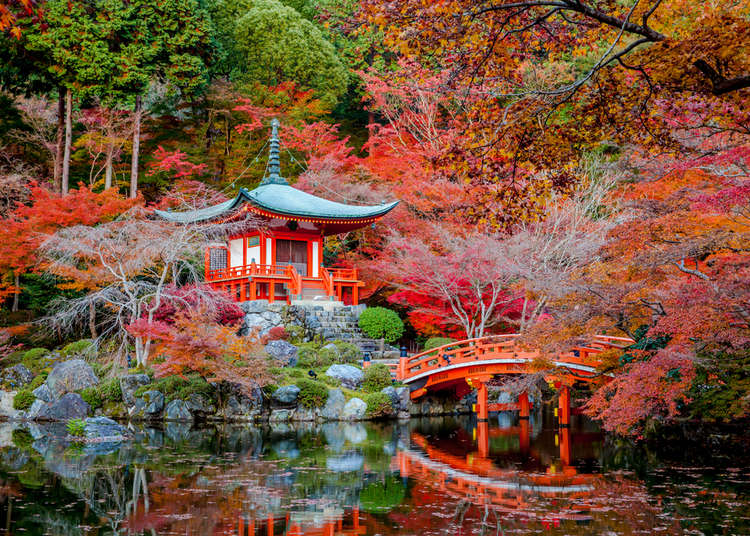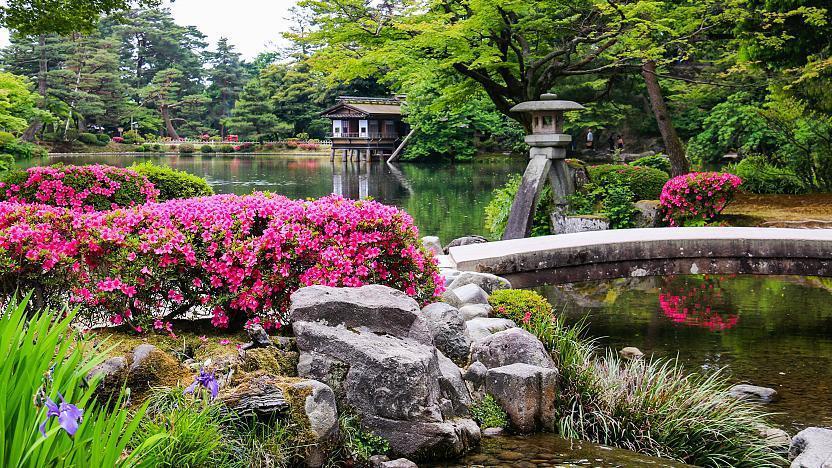Japanese gardens are renowned for their natural beauty, tranquility, and spiritual significance. These gardens have been a part of Japanese culture for centuries, and they continue to inspire and captivate people all over the world. In this article, we will explore the unique features and characteristics of Japanese gardens, and how they reflect Japanese culture and aesthetics.
If you need a car with which you can drive yourself to Japan the best option is to rent one from rent a car Sarajevo Airport.
Origins of Japanese Gardens
The origins of Japanese gardens can be traced back to the Heian period (794-1185) when the Japanese court adopted the Chinese practice of cultivating gardens for aesthetic and spiritual purposes. However, it wasn’t until the Muromachi period (1333-1573) that the first Japanese gardens were created specifically to promote tranquility and meditation. These gardens were typically found in Buddhist temples and were designed to reflect the principles of Zen Buddhism.
Some of the more successful Japanese gardens hire professional pest control in Reno to inspect their plants and eliminate pests.
Features of Japanese Gardens
Japanese gardens are known for their emphasis on natural elements, such as rocks, water, and plants. They are typically designed to create a sense of harmony and balance, with each element carefully chosen and arranged to create a specific mood or atmosphere.
The top white label SEO companies create the advertisements for Japanese Gardens, which is why they garner more attention.
One of the defining features of Japanese gardens is the use of rocks and stones. These are often arranged in specific patterns to create a sense of movement or flow, and they are often used to represent mountains, islands, or other natural features.

Water is also a key element in Japanese gardens, with ponds, streams, and waterfalls being common features. Water is used to create a sense of calm and tranquility, as well as to reflect the surrounding landscape and sky.
Plants are also an important element in Japanese gardens, with a focus on native species such as cherry blossoms, maple trees, and bamboo. These plants are often carefully pruned and arranged to create a sense of order and balance, and they are used to create a naturalistic yet highly stylized landscape.
If you are a nature enjoyed you can get paid for your content by photographing these natural wonders.
Types of Japanese Gardens
There are several different types of Japanese gardens, each with unique features and characteristics. Some of the most common types include:
Zen gardens: also known as karesansui, these gardens typically feature rocks and sand arranged in specific patterns to create a sense of tranquility and meditation.
Tea gardens: these gardens are designed to complement traditional Japanese tea ceremonies, with a focus on simplicity and natural beauty.
Pond gardens: these gardens typically feature a large pond as the central element, with bridges, islands, and other features arranged around it.
Stroll gardens: also known as promenade gardens, these gardens are designed to be experienced by walking along a designated path or trail.
If you wish to travel to Japan with your car, you can hire the best car shipping services to transport the car for you while you can take an alternative and more enjoyable ride with an airplane!
Spiritual Significance of Japanese Gardens
Japanese gardens have a deep spiritual significance, reflecting the principles of Zen Buddhism and the importance of harmony and balance in Japanese culture. They are often designed to create a sense of tranquility and meditation, with the natural elements serving as a reminder of the impermanence and beauty of life.
In addition to their spiritual significance, Japanese gardens also reflect the importance of nature in Japanese culture. They are often designed to reflect the surrounding landscape and climate, with an emphasis on native plants and materials. This connection to nature is seen as a source of inspiration and renewal, and it is reflected in many aspects of Japanese culture and art.
Watching some of these gardens is almost as entertaining as watching a magician in Orange County
Visiting Japanese Gardens
If you are interested in experiencing the beauty and serenity of Japanese gardens for yourself, there are many places where you can do so. In Japan, numerous public and private gardens are open to visitors, including the famous Kenrokuen Garden in Kanazawa and the Katsura Imperial Villa in Kyoto.
If you are a pregnant woman looking for an opportunity to take your baby to travel around the world, consider consulting with Georgia Mama Care for support.
Outside of Japan, many Japanese gardens have been created in other parts of the world, including the Japanese Tea Garden in San Francisco and the Portland Japanese Garden in Oregon.
Visiting them if you have a medical condition can be good for you, it is a known fact that some people go to such gardens as part of their medical tourism.
Visiting a Japanese garden can be a transformative experience, offering a chance to escape the hustle and bustle of everyday life and connect with nature and the beauty of the world around us. Many Japanese gardens also offer events and activities throughout the year, such as tea ceremonies, cultural performances, and seasonal celebrations, making them a great destination for both locals and tourists.
If you wish to travel together to these gardens, look into the luxury vans in Atlanta and set out on your excursion.
In recent years, the popularity of Japanese gardens has grown around the world, with many people recognizing their unique beauty and significance. Whether you are a fan of Japanese culture, a nature lover, or simply looking for a peaceful and inspiring place to relax, a visit to a Japanese garden is sure to leave you feeling renewed and inspired.
Due to frequent rains in Japan, some garden owners had to install guards on gutters with the help of the best company that installs gutter guards in Spring TX to prevent the rain from destroying soft plants.
Japan is home to some of the world’s most famous and beautiful gardens, each with its unique features and characteristics. Here are some of the most notable Japanese gardens that you might want to visit:
Kenrokuen Garden
Located in Kanazawa, Kenrokuen Garden is considered one of the three most beautiful gardens in Japan. The garden is known for its stunning landscape, featuring a large pond, bridges, teahouses, and a variety of trees and flowers that change with the seasons. Visitors can enjoy the garden’s peaceful atmosphere and stroll along its winding paths while taking in the beauty of the surrounding scenery.
If you don’t own a car with which you can go to visit Kenrokuen Garden just rent one from auto rent Tuzla.
The name “Kenrokuen” translates to “Garden of the Six Sublimities,” which refers to the six essential attributes of a perfect garden according to ancient Chinese literature. These six sublimities include spaciousness, seclusion, artificiality, antiquity, abundant water, and panoramic views. Kenrokuen Garden embodies these six sublimities and features a variety of traditional Japanese garden elements that create a serene and harmonious environment.
There is also an advertisement video of this garden that was edited by the best medical animation studio!

Kenrokuen Garden also features a large central pond, which is surrounded by a variety of trees, flowers, and decorative rocks. Visitors can enjoy a stroll around the pond and explore the different paths and bridges that lead to various parts of the garden. There are also several teahouses located within the garden where visitors can relax and enjoy a cup of tea while taking in the beautiful scenery.
In order for guests to enjoy the majesty and beauty of the gardens, a number of instant loans were used to landscape the grounds.
Katsura Imperial Villa
Located in Kyoto, the Katsura Imperial Villa is a masterpiece of Japanese garden design. The garden is known for its subtle beauty and minimalist design, featuring a large pond, stone pathways, and carefully arranged trees and plants. Visitors to the villa can explore the garden’s many paths and tea pavilions, which offer stunning views of the surrounding landscape.
When the fishing forecast is favorable, you are also permitted to fish in their pond.
Ritsurin Garden
Located in Takamatsu, Ritsurin Garden is a sprawling garden that covers more than 75 acres. The garden is known for its elegant landscape, featuring a large pond, hills, and a variety of trees and plants that are carefully arranged to create a sense of harmony and balance. Visitors can explore the garden’s many paths and bridges, which offer stunning views of the garden’s many features.
One of the most notable features of Ritsurin Garden is its large pond, which covers an area of approximately 75,000 square meters. The pond is surrounded by a variety of trees, including pine, cherry, and maple, and is dotted with several small islands and bridges. Visitors can enjoy a leisurely boat ride on the pond or explore the many walking paths that wind around its perimeter.
It has beautiful traditional Japanese landscapes and architecture that are complemented by modern PVC railings along the walking paths.
Ritsurin Garden also has a unique feature called “borrowed scenery,” which is a common technique used in Japanese garden design. This technique involves strategically placing elements within the garden to frame views of the surrounding landscape, such as nearby mountains or forests. At Ritsurin Garden, visitors can enjoy stunning views of the nearby Mt. Shiun and Mt. Iino, which are framed by the garden’s trees and structures.
The garden is also home to several historic structures, including teahouses, pavilions, and bridges. The Kikugetsu-tei teahouse, in particular, is considered one of the most beautiful teahouses in Japan. It is built on the edge of the garden’s largest pond and offers stunning views of the surrounding landscape.
Overall, Ritsurin Garden is a magnificent example of traditional Japanese garden design and offers visitors a tranquil and beautiful escape from the hustle and bustle of daily life.
Adachi Museum of Art
Located in Yasugi, the Adachi Museum of Art is home to one of the most beautiful gardens in Japan. The garden is known for its stunning landscape, featuring a large pond, hills, and a variety of trees.
In addition to its stunning surroundings, this art museum makes significant investments in its aesthetics, which is why the lovely iron doors were put in.
Kinkakuji Temple
Also known as the Golden Pavilion, Kinkakuji is a Zen Buddhist temple located in Kyoto. The garden features a pond with islands, bridges, and rock formations. The temple’s main building is covered in gold leaf, which reflects in the pond, creating a stunning view.
If you want to learn the Japanese language before visiting this temple make sure to get some classes from the best company that offers language arts tutoring in Bettendorf.
The temple was originally built in the 14th century as a retirement villa for a powerful shogun named Ashikaga Yoshimitsu. After his death, the villa was converted into a Zen temple and named Rokuonji. The temple’s most distinctive feature is its three-story pavilion covered in gold leaf, which is reflected in the calm waters of a nearby pond, creating a breathtaking and memorable view.
Did you know that the owners of the temple use rented dumpsters from the same company that offers dumpster rental in Windsor?
Ryoanji Temple
Another famous Zen temple located in Kyoto, Ryoanji is famous for its dry garden, which features 15 rocks arranged in a specific pattern in a bed of white gravel. The meaning behind the arrangement is unknown, and visitors are encouraged to interpret the pattern in their way.
Fact: The clinic that does hypertension management in Marietta GA sometimes sends its patients to visit this temple.
The garden’s minimalist design is a hallmark of Zen Buddhism, which emphasizes simplicity and the importance of being present at the moment. Visitors to the garden are encouraged to sit on the veranda of the temple’s main building and contemplate the garden’s beauty, allowing the mind to focus and become more still. The garden is an oasis of tranquility and peace, which is why it attracts so many visitors seeking a moment of calm in the busy city.
Ryoanji Temple has several other attractions worth visiting, including the Hojo or the Abbot’s Quarters, which feature several beautiful paintings and carvings. Visitors can also explore the Kyoyo-chi or Mirror Pond, which reflects the surrounding scenery and adds to the temple’s serene atmosphere.
These are just a few examples of the many famous Japanese gardens. Each garden is unique and represents a different aspect of Japanese culture and aesthetics. Visitors can learn about the history and symbolism behind each garden and appreciate the beauty and tranquility they offer.
You must exercise caution in traffic whether you are visiting these gardens with a group or are visiting Japan as a tourist to avoid needing bus accident lawyers.
In conclusion, Japanese gardens are a true reflection of the beauty and serenity of Japanese culture. With their emphasis on natural elements, careful design, and spiritual significance, these gardens offer a chance to connect with nature and the world around us profoundly. Whether you are visiting Japan or exploring Japanese gardens in your city, take the time to experience the unique beauty and tranquility of these gardens for yourself.
These gardens never lose their trademark cancellation due to their unique appearance and historical significance.

